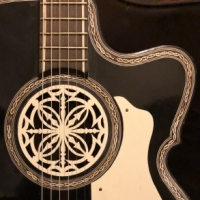DjangoBooks.com
Welcome to our Community!
Categories
- 20K All Categories
- 1.1K General
- 476 Welcome
- 59 Archtop Eddy's Corner
- 146 CD, DVD, and Concert Reviews
- 384 FAQ
- 26 Gypsy Jazz Italia
- 26 Photos
- 202 Gypsy Picking
- 21 Unaccompanied Django
- 15 Pearl Django Play-Along Vol.1
- 17 Gypsy Fire
- 45 Gypsy Rhythm
- 1.4K Gypsy Jazz University - Get Educated
- 130 Gypsy Jazz 101
- 224 Repertoire
- 218 History
- 707 Technique
- 51 Licks and Patterns
- 6 Daniel Givone Manouche Guitare Method Users Group
- 20 Eddie Lang Club
- 1.3K Gypsy Jazz Gear
- 801 Guitars, Strings, Picks, Amps, Pickups and Other Accessories
- 457 Classifieds
- 49 Recording
- 62 Other Instruments
- 18 Violin
- 5 Mandolin
- 22 Accordion
- 7 Bass
- 10 Woodwinds
- 347 Gypsy Jazz Events
- 143 North America
- 109 Europe
- 95 International
In this Discussion
Who's Online (0)
Selmer Vibro Effect - Busato tuning Fork
 MichaelHorowitz
SeattleAdministrator
MichaelHorowitz
SeattleAdministrator
Hi All,
Over the last few days a friend of mine lent me his 1946 Selmer petite bouche. It's the most time I've had to really play the "real thing" and I had a few interesting observations about it:
1) Volume was good, but not a cannon. Most Favinos, Busatos, etc are louder. That's probably what they were trying to do by using a longer scale and greater neck angle. However, this Selmer had a pretty low action setup which might have attenuated the volume somewhat.
2) The midrange was a little more present then in a Favino or Busato. So it had a thicker tone for lead lines. But less explosive and bright then a Busato. Also less low end too....over all the Selmer had a sweeter, but somewhat tamer tone then a Busato/Favino. For lack of a better term, the midrange had a "farty" quality to it. We'll see if that term catches on!
3) One of the things that I really noticed was this sort of "vibro" effect that the Selmer had. It was especially noticeable when playing 4 note chords on the top strings. The sound would "beat" and swirl like some sort of effect had been added. Very cool and complex character. I always heard this on django's recordings and thought it was just his vibrato and/or wow and flutter of the recording. But it's actually the guitar! You can hear it on the intro to famous J'attendrai clip.
I also noticed that a dupont Vieille Reserve that I have here has that same vibro type effect...and also has the "farty" midrange. When you put the VR next to a real Selmer you really see how good of a copy it is. Sounds so similar...the only difference I can hear is the definition and character that comes with age. My guess is that Selmers probably sounded just like the VR when they were new. Kudos to Maurice dupont....I don't think anyone is making a Selmer copy that good!
4) By comparison, the Busato totally lacked the midrange and "vibro" type quality of the Selmer. Instead, it has a more cutting high end and deeper low end. But not much mids. One of it's strongest characteristics is the sign wave like quality to the notes. Unlike the complex character of the Selmer, the Busato gives a very pure tone with a very, very strong fundamental. The overtones that are there sound very even. I think Bob Holo has actually confirmed this with a spectral analysis. By comparison, the Selmer sounded like it has a lot more odd harmonics and "breakup." Bob actually remarked once that Busatos are like tuning forks!
I can't say one is better then the other...just different. One thing is for sure though, the Busato will spank the Selmer in a campfire jam. The bright, clean, fundamental rich tone it has will cut through anything.
Anyway, just thought I'd share that. Not too often I get guitars of that caliber side by side.
'm
Over the last few days a friend of mine lent me his 1946 Selmer petite bouche. It's the most time I've had to really play the "real thing" and I had a few interesting observations about it:
1) Volume was good, but not a cannon. Most Favinos, Busatos, etc are louder. That's probably what they were trying to do by using a longer scale and greater neck angle. However, this Selmer had a pretty low action setup which might have attenuated the volume somewhat.
2) The midrange was a little more present then in a Favino or Busato. So it had a thicker tone for lead lines. But less explosive and bright then a Busato. Also less low end too....over all the Selmer had a sweeter, but somewhat tamer tone then a Busato/Favino. For lack of a better term, the midrange had a "farty" quality to it. We'll see if that term catches on!
3) One of the things that I really noticed was this sort of "vibro" effect that the Selmer had. It was especially noticeable when playing 4 note chords on the top strings. The sound would "beat" and swirl like some sort of effect had been added. Very cool and complex character. I always heard this on django's recordings and thought it was just his vibrato and/or wow and flutter of the recording. But it's actually the guitar! You can hear it on the intro to famous J'attendrai clip.
I also noticed that a dupont Vieille Reserve that I have here has that same vibro type effect...and also has the "farty" midrange. When you put the VR next to a real Selmer you really see how good of a copy it is. Sounds so similar...the only difference I can hear is the definition and character that comes with age. My guess is that Selmers probably sounded just like the VR when they were new. Kudos to Maurice dupont....I don't think anyone is making a Selmer copy that good!
4) By comparison, the Busato totally lacked the midrange and "vibro" type quality of the Selmer. Instead, it has a more cutting high end and deeper low end. But not much mids. One of it's strongest characteristics is the sign wave like quality to the notes. Unlike the complex character of the Selmer, the Busato gives a very pure tone with a very, very strong fundamental. The overtones that are there sound very even. I think Bob Holo has actually confirmed this with a spectral analysis. By comparison, the Selmer sounded like it has a lot more odd harmonics and "breakup." Bob actually remarked once that Busatos are like tuning forks!
I can't say one is better then the other...just different. One thing is for sure though, the Busato will spank the Selmer in a campfire jam. The bright, clean, fundamental rich tone it has will cut through anything.
Anyway, just thought I'd share that. Not too often I get guitars of that caliber side by side.
'm
Tagged:













Comments
That's a fascinating observation about the "vibro effect." Does it increase as you move up the fret-board or is it consistent along the entire neck?
A couple thoughts came to mind when reading your post. What you describe reads like there is something just s.l.i.g.h.t.l.y out of tune between the strings that is noticeable as you strike 4-tone chords. Could it be that the frets are angled ever so minutely from being absolutely perpendicular to the long axis of the neck? Maybe as an effort to compensate for the different string diameters. Or might the frets have a slight curve in them along their length? Either situation would introduce just enough "dis-harmony" so as to create the "pulse" effect you describe.
Either situation would also require an extremely competent luthier to execute properly without "overdoing" it.
I'd say it's more noticeable on the upper strings and higher up the neck. But any chord, played anywhere on the Selmer had a more complex character to it then the Busato. The Busato's chords are ultra clean and defined with extremely good separation of the notes. The Selmer sounded a little messier but cool and interesting!
Yes...a bit like being out of tune.
Maybe...or it just may have something to do with the ultra thin top, pliage, less neck angle. The Selmer guys were just furniture makers trained to make guitars. I'm not sure they really were trying to get this effect...
While craving the information in this post comparing great guitars, I was less than thrilled only with the descriptor "farty".
Can you can improve on or explain more of what you meant by "farty"!
Thanks
Not the most elegant term...but we need to keep a sense of humor about all this!
Listen to this Mp3 of Django. This is what I mean...
'm
you mean thr overdrive sound? that could be his playing or it could be the recording technique.
Learn how to play Gypsy guitar:
http://alexsimonmusic.com/learn-gypsy-jazz-guitar/
no, it's the guitar. Just had one in my hands and it did the same thing.
'm
yeah...that's it. Every Selmer I've played does that.
I really don't know which voice I liked best. Bottom line, an exceptional guitar is an inspiring thing to experience and exceptional guitars were dripping off the walls that day due to some very nice people who care about the future of this music. Many thanks and much kudos to them.
I have to say though, Michael - just my humble opinion, but Selmer 5XX was alone in recreating that effect exactly (from the front side of the guitar anyway) The VR & the Cedar Selmer each had a darned good interpretation of that effect - certainly as good as I've heard in modern guitars, but only Selmer 5xx nailed it to the point where it was just uncanny. It really inspired me to do more thinking about matching the characteristics of early soundboard spruce (pre Norwegian Spruce) and understanding the pliage better. It was very unique and didn't look like the Charle pliage or for that matter the Dupont pliage. I don't know if that's just due to movement of the top over time, but its arch looked perfect so I'm guessing there's somehting else in play. Another thing that really baked my noodle was that it was sporting one of Josh's new Bigtones - so it wasn't a pure acoustic bridge. He's really nailing the acoustic tone with those things now and I like the fact that he's offering a "vintage friendly" install option... (i.e., no friggin holes in the soundboard)